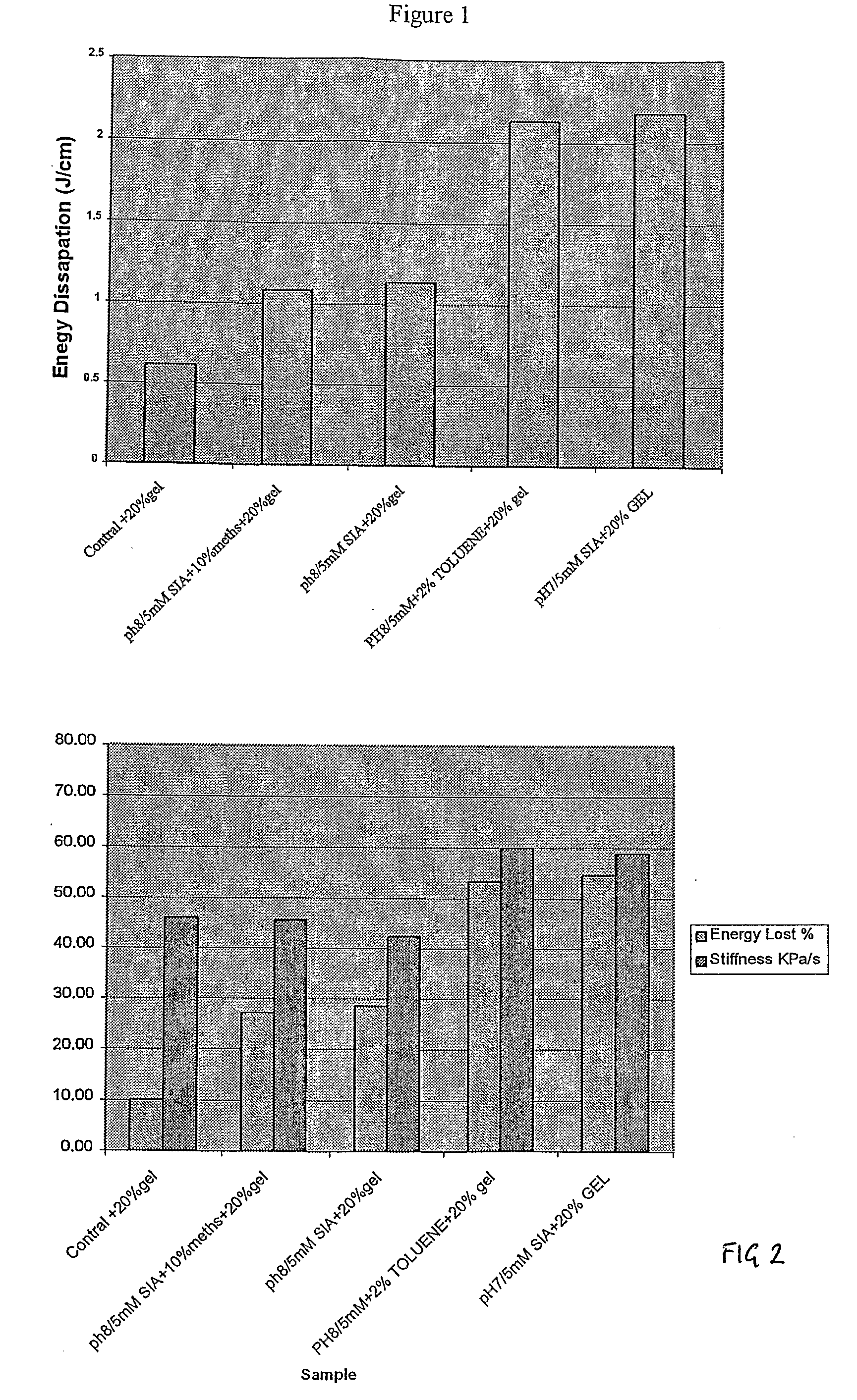Pressure impulse mitigation
a technology of pressure impulse and mitigation, applied in the field of new materials, can solve the problems of inability to minimise the effects of explosions, death, injury and destruction of property and buildings, and the inability of intelligence and police operations alone to prevent explosions, so as to prevent further contamination, and reduce the toxicity of chemicals
- Summary
- Abstract
- Description
- Claims
- Application Information
AI Technical Summary
Benefits of technology
Problems solved by technology
Method used
Image
Examples
example 2
[0145]The cross linked gel samples in the 280 ml plastic food containers were tested for their ballistics capacity using a 0.22 rifle. The entry and exit speeds of the bullet were measured by light gates at entry and on exit. As the mass of the bullet is known the energy dissipated per cm of the approximately 15 cm flight path through the gel can be estimated. The results for energy dissipation in Jcm−1 are set out in FIG. 1 and a comparison of % energy loss and stiffness in KPa are set out FIG. 2.
% Energy Loss Results
[0146]The control sample indicates that average energy loss for the non cross-linked gel is around 0.6 J / cm. The average energy losses fell into three distinct categories with the strongest samples being some 4 times stronger than the control:
A) The control at approximately 0.6 J / cm;
B) The pH 8.0 pre-incubation at both 1% and 5% v / v methanol solvent concentrations, both at approximately 1.1 J / cm; and
C) The pH 8.0 pre-incubation at 2% v / v toluene and the pH 7 pre-incuba...
example 3
Preincubation
[0148]A 1.85 to 2.0% w / v gelatin solution was prepared directly in Peptone Buffer Saline (PBS) and allowed to cool slowly to room temperature. The pH of this solution was then adjusted as required to pH 6.75-7.25. The solution was maintained at temperatures between 20-25° C.
[0149]The solution was then divided into 100 ml aliquots in Pyrex vessels.
[0150]Sebacic acid bis N-succinimidyl ester (SANHSE) was prepared immediately prior to use. The reactions described were carried out at a final theoretical reagent concentration of 5 mM, which equates to 200 mg of SANHSE per ml of solvent. The SANHSE samples were solubilised / emulsified in 1 ml of either 95% methanol, 100% methanol or toluene.
[0151]The gelatin solution was placed on a magnetic stirrer and spun into a vortex. The reagent was added and the solution allowed to spin for a further 30 seconds to allow complete dispersal. The preincubated samples were maintained at 22-24° C. for up to 4 hours. Every 15-20 minutes the v...
example 4
Production of a 28% w / w Cross Linked Water Gel
[0153]A solution of 35% w / w of gelatin in aqueous solution is prepared and adjusted to a final pH of 7.1-7.3 by the addition of 10% sodium hydroxide solution. The solution is maintained at a temperature of 40-45° C. If the resulting gel is to be kept for any length of time methyl paraben (0.2%) and propyl paraben (0.15%) should be included in the final mix as anti-microbial agents. This constitutes Solution A.
[0154]The pre-polymer solution is prepared by diluting down a volume of Solution A to produce a final concentration of gelatin of 1.8%, the pH is adjusted to 6.7-6.9, and the solution is allowed to cool to 20-25° C. The SANHSE is emulsified in methanol at a concentration equivalent to a 10% solution. The reagent is then added to the 1.8% gelatin solution and stirred continuously but slowly for 30-35 minutes. The temperature is maintained at 20-25° C. throughout. This constitutes Solution B.
[0155]Once the preincubation of Solution B ...
PUM
| Property | Measurement | Unit |
|---|---|---|
| temperature | aaaaa | aaaaa |
| temperature | aaaaa | aaaaa |
| pH | aaaaa | aaaaa |
Abstract
Description
Claims
Application Information
 Login to View More
Login to View More - R&D
- Intellectual Property
- Life Sciences
- Materials
- Tech Scout
- Unparalleled Data Quality
- Higher Quality Content
- 60% Fewer Hallucinations
Browse by: Latest US Patents, China's latest patents, Technical Efficacy Thesaurus, Application Domain, Technology Topic, Popular Technical Reports.
© 2025 PatSnap. All rights reserved.Legal|Privacy policy|Modern Slavery Act Transparency Statement|Sitemap|About US| Contact US: help@patsnap.com


